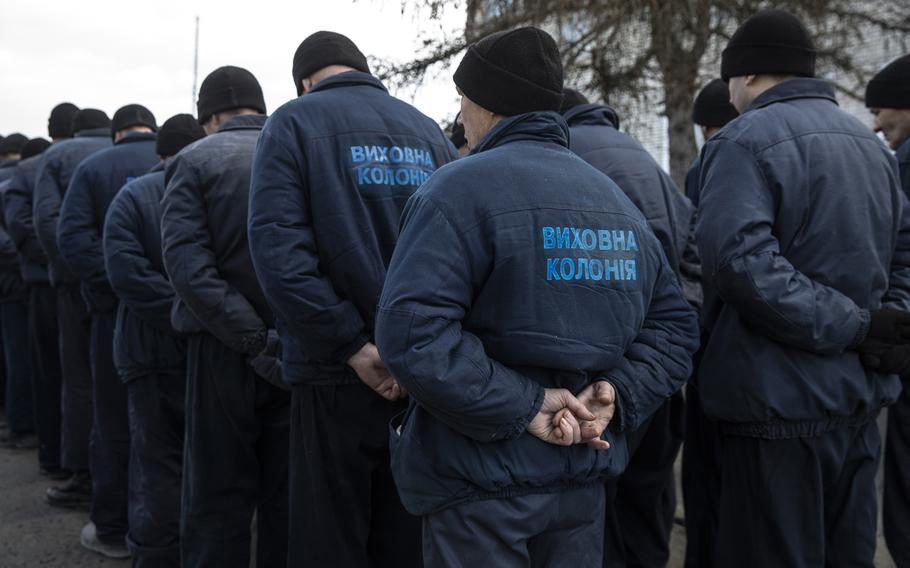Europe
'This is our exchange fund': Inside Ukraine's POW detention center
Special to The Washington Post January 27, 2023

Russian prisoners of war captured by Ukrainian forces during the conflict stand with their hands held behind their backs as they walk slowly towards a building for lunch at a Ukrainian detention camp located in western Ukraine on Jan. 17, 2023. (Heidi Levine/for The Washington Post)
WESTERN UKRAINE — Finally, it was his turn in a long line of men in matching navy uniforms. Pavlo Klimash recited a phone number to the security guard and then stated his name, preceded by "prisoner of war."
"I'm calling my mother," he said.
No one answered. He tried again, but still no one picked up. Fifteen-minute phone calls home are only possible once or twice a month. Klimash would have to wait at least two more weeks before trying again.
The Washington Post recently visited a detention center where Ukraine is holding prisoners of war. Prisoners interviewed — some from Russia and some from the Donetsk and Luhansk regions of Ukraine, which have been run by Russian proxies since 2014 — were asked by journalists for their consent. Security guards stood nearby, but did not intervene. Prisoners who are being charged by Ukraine for committing war crimes were not allowed to be interviewed.
Officials at the detention center asked journalists not to reveal the precise location of the prison nor how many prisoners are being held there because it could jeopardize future exchanges. Eleven months into Russia's invasion of Ukraine, prisoner-of-war exchanges have become a rare intersection of mutual interest for the two countries and typically occur multiple times per month.
The prisoners at this camp in western Ukraine walked without handcuffs around their wrists, instead linking their hands behind their backs and keeping their heads down. Only the guards posted outside were armed. The staff inside the center said it's a revolving door: new prisoners arrive every week just as others leave to be exchanged. Once home, they could be sent back to the front.
"I don't want to fight, but if they tell me to again, then so be it," said Oleg Asedulin, a 45-year-old mortar man. "We were sent to war to fight for ourselves, and it is not clear against whom or for whom."
Asedulin has been at this detention center for four months and was working in the kitchen the day Post journalists visited. Lunch was soup, meat and potatoes and a pink cabbage salad. The prisoners sat at tables covered in a tablecloth with sunflowers printed on it. It lasted 15 minutes before they all stood together and said in unison, "Thank you for lunch."
There's a fixed daily schedule that includes three meals and household chores and activities, including needlework and creating paper bags designed with the western Ukrainian city of Lviv on them. A razor-wired fence wraps around the outside walls. There is 24-hour video surveillance. Men sleep in twin-size bunks lined up in two rows — about 20 beds to a large room.
Some prisoners arrive here with injuries, including lost limbs, and are treated in an infirmary.
Igor Buzunov, 45, was captured by Ukrainian forces in September after he hurt his left arm in a mine explosion. He kept it tucked under his jacket.
In central Russia, he worked as a locksmith and at construction sites for 15 years before signing a military contract. He said he was motivated by what he heard on Russia state television — that Russian-speaking Ukrainians in Donetsk and Luhansk were being oppressed by authorities in Kyiv.
"But when I got to Ukraine and spoke to locals here, I was convinced of something else," Buzunov said. "Let Ukraine itself resolve its conflicts on its own regarding Donetsk and Luhansk, regarding land and territory."
In one room, prisoners watched a television showing a Ukrainian news channel with reports of Russian attacks on Ukrainian cities and civilian casualties. Around the facility are boards displaying Ukrainian symbols — the flag, the coat of arms and maps that include Crimea as part of Ukraine, though Russia invaded and illegally annexed the peninsula in 2014.
On one of the outside walls, staff hung portraits of Ukrainian rulers dating back to the 16th century — a way to impress upon the prisoners here the antiquity of Ukrainian statehood.
Outside of the prison, a 30-year-old woman, Oksana, walked by the central gate with her dog and two children. Does she know who is inside?
"Of course," she said. "This is our exchange fund. The main thing is that ours will come home."